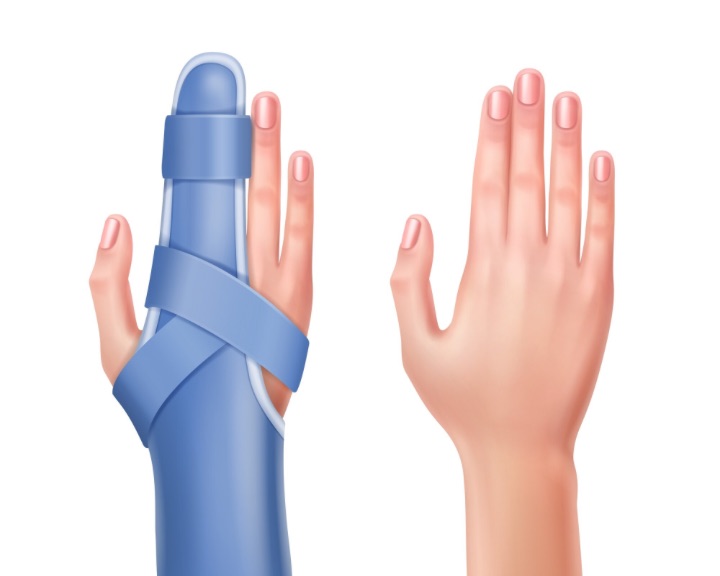Carpal tunnel syndrome occurs when the median nerve, which runs from the forearm to the hand, is compressed within the carpal tunnel in the wrist.
This compression can result in a range of symptoms, including wrist pain, hand numbness, and tingling fingers, which can greatly impact an individual’s daily life.
Carpal tunnel syndrome is a condition that affects the wrist and hand, caused by compression of the median nerve in the carpal tunnel. The carpal tunnel is a narrow passageway formed by wrist bones and a fibrous band, through which the median nerve and tendons pass.

Photo Credit: Freepik
Compression of the median nerve leads to symptoms such as hand numbness, tingling fingers, and broken wrist pain. These symptoms may worsen with time, reducing hand strength and coordination.
The median nerve is responsible for sensation and movement in the thumb, the first three fingers, and parts of the hand muscles. When the median nerve is compressed, it interferes with the nerve signals, resulting in hand numbness, tingling fingers, and wrist pain.
As carpal tunnel progresses, the muscles in the hand may weaken, and individuals may experience difficulty gripping or holding objects, dropping things more frequently than usual.
The most common symptoms of carpal tunnel syndrome include:
These symptoms may occur more frequently at night or during activities that involve repetitive wrist movements.
Carpal tunnel is caused by the compression of the median nerve that passes through the carpal tunnel in the wrist. Several factors can contribute to this compression.
One of the most common causes of carpal tunnel syndrome is repetitive strain injury. This type of injury is caused by repeatedly performing the same hand and wrist motions, such as typing on a keyboard or using a mouse.

Photo Credit: ArtPhoto_studio
Over time, this can cause inflammation and pressure on the median nerve, leading to carpal tunnel syndrome.
Some people may have a smaller carpal tunnel, which increases the likelihood of the median nerve becoming compressed. Additionally, some individuals may have abnormalities in the wrist bones or ligaments that can lead to median nerve compression.
Certain medical conditions can also contribute to the development of carpal tunnel. These include diabetes, hypothyroidism, and rheumatoid arthritis. These conditions can cause swelling and inflammation, which can lead to compression of the median nerve.
Pregnant women are also at a higher risk of developing carpal tunnel syndrome. This is due to hormonal changes that can cause fluid retention and swelling in the wrists and hands, leading to median nerve compression.
Understanding the various causes of carpal tunnel can help individuals identify potential risk factors and take preventative measures to reduce their risk of developing this condition.
Carpal tunnel can be identified by several symptoms that can gradually worsen over time. The symptoms occur due to the compression of the median nerve, which runs from the forearm into the hand through the narrow carpal tunnel in the wrist.
Individuals with carpal tunnel syndrome frequently experience wrist pain and discomfort, especially at night. The pain may also radiate to the forearm and elbow.
Another common symptom is hand numbness or a tingling sensation. This sensation can affect the thumb and fingers, including the ring and little fingers.
Individuals with carpal tunnel may experience muscle weakness in their hand, making it difficult to grip, hold or grasp objects. This can lead to an overall lack of coordination and clumsiness.
Some individuals may experience a burning and itching sensation in their hands, which can be uncomfortable and disruptive to daily life.

Photo Credit: azerbaijan_stockers
It is essential to seek medical attention if these symptoms persist or worsen over time. A physician can diagnose the condition and recommend appropriate treatment.
Various treatment options are available to manage carpal tunnel symptoms. The choice of treatment largely depends on the severity of the condition. Below are some of the most common treatments for carpal tunnel syndrome:
Wrist splints are often recommended for individuals with mild to moderate carpal tunnel. These splints help to keep the wrist in a neutral position, reducing the pressure on the median nerve and alleviating symptoms such as hand numbness and tingling.
Specific exercises can help to stretch and strengthen the muscles in the hand and wrist, alleviating the symptoms of carpal tunnel syndrome. These exercises may be recommended by a physiotherapist or occupational therapist.
For severe cases of carpal tunnel, surgery may be necessary. The surgery involves cutting the carpal ligament to reduce pressure on the median nerve. This procedure is usually performed under local anaesthetic; patients typically experience good outcomes.
It is important to note that while surgery can provide relief, it is not always necessary. Before opting for surgery, exploring other non-invasive treatment options is advisable.
If you are experiencing carpal tunnel syndrome symptoms, seeking medical advice is essential. A qualified health professional can assess your condition and provide tailored advice on the best course of treatment.
There are several treatment options available for managing carpal tunnel syndrome symptoms. The treatment plan may vary depending on the severity of the condition and individual needs. Here are some of the most common treatment options:
Wrist splints are often recommended as the first course of treatment for carpal tunnel syndrome. These splints help keep the wrist in a neutral position, alleviating the pressure on the median nerve.

Photo Credit: macrovector
They are typically worn at night, but may also be worn during the day if necessary. Choosing a wrist splint that fits properly and provides adequate support is important.
Specific exercises can help strengthen the muscles in the hand and wrist, reducing the risk of carpal tunnel syndrome or alleviating symptoms for those already experiencing it. Physical therapy may include stretching, wrist rotations, and grip-strengthening exercises. A physical therapist can guide appropriate exercises and techniques.
In some cases, surgery may be necessary to relieve the symptoms of carpal tunnel syndrome. During the procedure, the surgeon will cut the ligament that is causing the compression on the median nerve. This can help to restore normal function and alleviate symptoms. Recovery time can vary, but most people can return to normal activities within a few weeks.
It is important to consult with a healthcare professional to determine the most appropriate treatment plan for managing carpal tunnel syndrome symptoms. A combination of treatment options may be recommended for optimal results.
A: Carpal tunnel syndrome is a condition characterized by the compression of the median nerve in the wrist, resulting in symptoms such as wrist pain, hand numbness, and tingling fingers.
A: Carpal tunnel syndrome affects the wrist by causing inflammation and swelling in the carpal tunnel, a narrow passageway on the palm side of the wrist. This can lead to pressure on the median nerve, causing various symptoms.
A: Common symptoms of carpal tunnel syndrome include wrist pain, hand numbness, and tingling fingers. These symptoms can often worsen at night or during activities that involve repetitive hand and wrist movements.
A: Carpal tunnel syndrome can be caused by various factors, with the most common being repetitive strain injury. Activities that involve repetitive hand and wrist movements, such as typing or using vibrating tools, can contribute to the development of carpal tunnel syndrome.
A: Treatment options for carpal tunnel syndrome can include using wrist splints to immobilise the wrist, specific exercises to improve hand and wrist strength, and in some cases, surgery may be necessary to relieve pressure on the median nerve.
A: Carpal tunnel syndrome can be prevented by practising good ergonomics, such as maintaining proper wrist alignment during activities, taking regular breaks to rest the hands and wrists, and making lifestyle changes to avoid repetitive strain injuries.